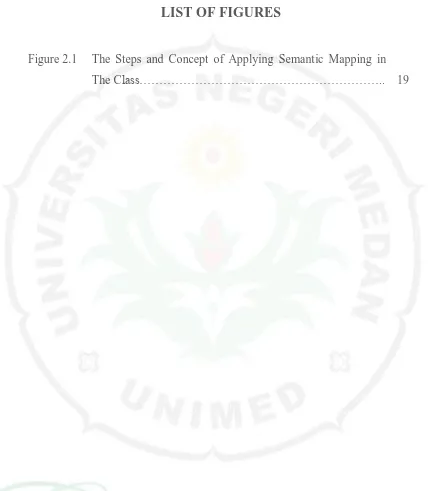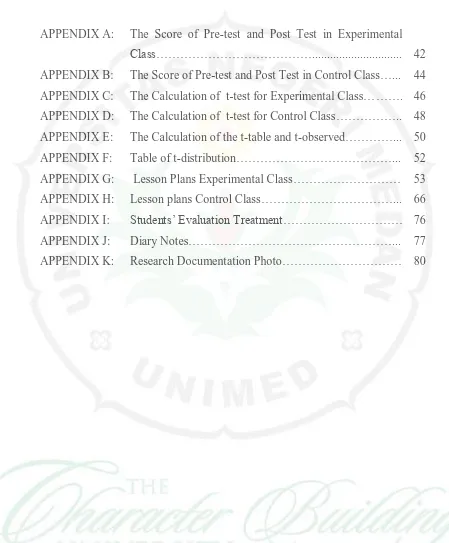THE EFFECT OF SEMANTIC MAPPING STRATEGY ON
STUDENTS’
SPEAKING ACHIEVEMENT IN SMP NEGERI 1
SEI SUKA
A THESIS
Submitted to Partial Fulfillment of the Requirements for the Degree of Sarjana Pendidikan
By :
LIZA INSYIRAH
Registration Number : 2101121026
ENGLISH AND LITERATURE DEPARTMENT
FACULTY OF LANGUAGES AND ARTS
i
ABSTRACT
Insyirah, Liza. Nim 2101121026. “The Effect of Semantic Mapping Strategy on Students’ Speaking Achievement in SMP Negeri 1 Sei Suka”. A Thesis. Faculty of Language and Arts (FBS), State University of Medan (UNIMED). 2014.
This study aims to discover the effect of applying Semantic Mapping Strategy on students’ speaking achievement. It was conducted by using experimental research design. The population of this research was the eight (VIII) grade students of SMP Negeri 1 Sei Suka. The samples of the research were two classes which consisted of experimental and control group which were chosen by using random sampling technique. Thirty one students were taken as the samples in each class. The experimental group was taught by using Semantic Mapping Strategy, while the control group was taught without using Semantic Mapping Strategy. After analyzing the data, it was found that the value of tobserved was 3,12 with the degree of freedom (df)=60 at the level of significance p(0,05) = 2,000. It means that tobserved was higher than ttable (3,12>2,000). The result of this study showed that Semantic Mapping Strategy was significantly affect on students’ speaking achievement.
ii
ACKNOWLEDGEMENT
First of all, the writer would like to thank to the Almighty Allah SWT for His blessings, so the writer is able to accomplish her thesis as a partial fulfillment of the requirements for the degree of Sarjana Pendidikan at the English
Department, Faculty of Languages and Arts (FBS) in State University of Medan (UNIMED).
During the process of writing, the writer realizes that she can’t accomplish
without support from many people. The writer would like to express her sincere
gratitude to:
Prof. Dr. Ibnu Hajar Damanik M.Si., as Rector of State University of
Medan.
Dr. Isda Pramuniati, M.Hum., as Dean Faculty of Languages and Arts.
Prof. Dr. Hj. Sumarsih, M.Pd., as the Head of English Department, and
her Thesis Reviewer.
Dra. Masitowarni Siregar, M.Ed., as the Head of Education Program of
English Department and her Thesis Reviewer.
Dra. Tjut Ernidawati, M.Pd., as her Thesis Supervisor
Dra. Sortha Silitonga, M.Pd, as her Academic Consultant and Dra.
Meisuri, MA., as her Thesis Reviewer.
Drs. Sugito, M.M, as the Principal of SMP Negeri 1 Sei Suka and Miss
Zetty as the English Teacher who had helped her during the research in the
iii
The writer’s beloved parents, H. Kimsul Musa Syafi’i and Hj. Sudarmi,
BA., for their endless love, supports, motivations, and prayers during the
writer’s whole life, her only one older sister Khairun Nissa, SE., her
brother in law Indra Mulyadi, ST., for their supports and love. Her gratitude is also expressed to her beloved uncles and aunts for their prayers
and mental support, Ir. Edi Susanto, M.Si., Ahmad Syofyan, SE. M.Si, Ida Susanti, ST., and Risna, SE.
All class members of Regular A, B, C 2010.
Her best 5, Halimatun Husna Rambe, Angrayni Dian Novia, Risqa
Indina, and Anisa, her close friends Sri Wahyuni and Muhammad
Yusuf, her beloved seniors, Rizky Bita GH. Siregar, S.Pd., Azhar Aziz
Lubis, S.Pd., Dedi Sanjaya Hasibuan, S.Pd., her whole life friends,
Rika Ramadani Nasution, Rizky Yosiningtiastuti, and Green Alfath
Siregar, and for her beloved HMJ-BSI Unimed, and UKMI Ar-Rahman
Unimed, and all the members of that.
Medan, Juli 2014 The Writer,
iv
E. The Significance of the Study... 4
CHAPTER II. REVIEW OF LITERATURE….……….. 5
A. Theoretical Framework…... 5
1. Students’ Achievement in Speaking... 5
2. Speaking... 7
a. Teaching Speaking... 7
b. The Assessment of Speaking... 9
3. Strategy... 10
4. Semantic Mapping Strategy….………. 11
a. Semantic Mapping as Graphic Organizers….……….. 11
b. The Reasons of Using Semantic Mapping………... 12
c. The Procedure of Using Semantic Mapping Strategy……. 15
d. The Advantages of Semantic Mapping………... 17
B. Conceptual Framework... 20
v
CHAPTER III. RESEARCH METHOD...………. 22
A. Research Design... 22
B. Population and Sample... 22
1. Population... 22
2. Sample... 23
C. The Instrument of Collecting Data... 23
1. Assessment and Scoring of Speaking... 23
D. The Procedure of Treatment….……….. 25
1. Pre-Test….……… 25
2. Treatment……….. 25
3. Post-Test………... 28
E. The Technique for Analyzing Data... 28
F. The Statistical Hypothesis... 29
CHAPTER IV. DATA AND RESEARCH FINDING………. 30
A. Data ……… 30
B. Data Analysis ………. 35
1. Analyzing The Data Using T-test ………. 35
2. Testing the Hypothesis……….. 35
C. Research Finding………. 36
CHAPTER V. CONCLUSION AND SUGGESTION………. 39
A. Conclusion……… 39
B. Suggestion ….………... 39
REFERENCES... 41
vi
LIST OF TABLES
vii
LIST OF FIGURES
Figure 2.1 The Steps and Concept of Applying Semantic Mapping in
viii
LIST OF APPENDICES
APPENDIX A: The Score of Pre-test and Post Test in Experimental
Class………... 42
APPENDIX B: The Score of Pre-test and Post Test in Control Class…... 44
APPENDIX C: The Calculation of t-test for Experimental Class………. 46
APPENDIX D: The Calculation of t-test for Control Class……….. 48
APPENDIX E: The Calculation of the t-table and t-observed…………... 50
APPENDIX F: Table of t-distribution………... 52
APPENDIX G: Lesson Plans Experimental Class……… 53
APPENDIX H: Lesson plans Control Class………... 66
APPENDIX I: Students’ Evaluation Treatment……… 76
APPENDIX J: Diary Notes………... 77
41
REFERENCES
Amoush, Kholoud Hussei. The Effectiveness of Using “Semantic Mapping strategy” on Reading Comprehension of Jordanian University Students. ijcrb.webs.com,Vol 4, No. 6, October 2012
Ardila, Lubis and Sumarsih. 2013. Improving Students’ Speaking Achievement in Reporting Procedure Text by Using Video. Medan: State University of Medan
Ary, Donald. et al. 2010. Introduction to Research in Education Eight Edition. New York: Wadsworth Cengage Learning
Bita GH, Rizki. 2013. The Effect of Student Team Achievement Division (STAD)
Method on Students’ Speaking Achievemsent at SMP Negeri 1
Perbaungan. Medan: State University of Medan
Boon Yih, Mah. 2011. Semantic Mapping: A Visual and Structured Pre-writing Strategy in the Process of Essay Writing. ESTEEM Academic Journal UiTM Pulau Pinang, 7, 81–92.
Brown, H Dowglas. 2004. Language Assessment: Principles and Classroom Practices, Chapter 7. San Francisco: Pearson Longman.
Ellis, Edwin. 2004. Q&A: What’s the Big Deal with Graphic Organizer. www.GraphicOrganizers.com, (251) 961-2407
Emor, Jenny; Suhartono, Luwandi; and Riyanti, Dwi. 2012. Using Semantic Mapping in Teaching Vocabulary Through Descriptive Text. Pontianak: Tanjungpura University
Folse, Keith S. 2006. The Art of Teaching Speaking: Research and Pedagogy for the ESL/EFL Classroom. Ann Arbor: The University of Michigan
Fulcher, G. 2003. Testing Second Language Speaking. San Francisco: Pearson Education
Hughes, Rebecca. 2002. Teaching and Researching Speaking. San Francisco: Longman
Http://kakaris.wordpress.com/2009/09/14/rubric-of-speaking-assessment/ (Retrieved, June 16th, 2014 @09.25 am)
L. Shoemaker, Connie and Shoemaker, F. Floyd. 1991. Interactive Techniques for the ESL Classroom. Boston: Heinle and Heinle Publisher.
Nation, I.S.P and Newton, J. 2009. Teaching ESL / EFL Listening and Speaking. London: Routledge Taylor and Francis Group.
NCLRC http://www.nclrc.org/essential/speaking/developspeak.html (Retrieved, December 9th, 2013 @11:35 am)
Ngoc Thuy, Nguyen. 2003. The Effects of Semantic Mapping on Vocabulary Memorizing. www.asia-efl-journal.com, Viet Nam
Richards, Jack C and Renandya, Willy A. 2002. Methodology in Language Teaching. London: Cambridge University Press
Setiyadi. 2006. Teaching English as a Foreign Language. Yogyakarta: Graha Ilmu
Siahaan, S and Sinoda. 2008. Generic Structure. Yogyakarta: Graha Ilmu
Stone, Jeanne M. 2007. Cooperative Learning Reading Activities. Canberra: Hawker Brownlow Education
Taigin, D. 1995. A Strategy for Effective Inter Class Oral Communication. Forum, 28
1
CHAPTER I
INTRODUCTION
A. Background of the Study
Nowadays, Kurikulum 2013 had already been launch by our government.
Even though Kurikulum 2013 was still using for the grade I of Junior High School. In grade II of Junior High School was still using the curriculum that progresses now that it was called A Kurikulum Tingkat Satuan Pendidikan
(KTSP). In this curriculum, the aim of the English teaching in Indonesia especially teaching English to Junior High School was to enable students to have
the ability in developing communicative competence in both oral and written, to have the awareness about the essence and the important of English in increasing competition in global community, and the last was to develop the students’
comprehension about interrelatedness between language and culture. It could be concluded that Junior High School students were demanded to master the
communicative competence both in spoken and written form in order to compete in the globalization era.
In teaching English, there are four skills to be taught to master the aspect of lessons. They are writing, reading, listening, and speaking. Its skill has different meaning but has the same purpose, which is increasing the creativity of
2
Based on my teaching experience in SMP Negeri 1 Sei Suka, there were
still many students who hadn’t able to speak English well. In addition to the data
that I got, I also interviewed the teacher to ask their methods and difficulties in
teaching. There were some factors that found in this problem could be predicted as follows:
First, the teacher found that their methods were used by them still valued
passive interaction from students. The speaking practice was done just by giving instruction so that the students were less interest.
Second, the students just memorized the conversation given by teacher to show their speaking ability. It could not help the students to have a communicative dialogue.
These all reasons made the students just sitting and following passively in teaching learning process. There were 31 students in Grade VIII-1 and 15
students could not pass the minimum standard competence (KKM) which was applied by school for English lesson. The score of minimum standard competence
was 75.
3
mapping is powerful tool in concept development and information ex-change.
According Richards (2001: 198) semantic mapping belongs to cooperative learning and it has several characteristic, such as different topic for each group,
the new information, presentation in front of the class, and structured group work effectively.
In accordance with Indonesian curriculum, junior high school students
have to learn descriptive text in the seventh and eighth grade. A descriptive text is a text that describes the features of someone, something, or a certain place.
Descriptive text has the purpose of the text is to tell about the subject by describing it features without including personal opinion.
Based on the explanation above, it’s very important to increase the
students’ ability in speaking. According to the writer, the eighth grade students of
junior high school were better to learn speaking the description of the features of
someone, something, or a certain place by using Semantic Mapping Strategy.
B. Problem of the Study
As related to the background of the study, the problem is formulated as follows:
4
C. Objective of the study
In the relation to the problem of study, the objective of the study was to find out the effect of Semantic Mapping Strategy on Students’ Speaking
Achievement.
D. The Scope of the Study
There were many ways to create the teaching learning process that teacher could do to improve student’s achievement especially in teaching English to make
the students were interested in speaking English. This study focused on applying
Semantic Mapping Strategy to see Students’ Speaking Achievement. Semantic
Mapping was categorized on one of visual graphic organizers.
E. The Significance of the Study
The findings were expected to be useful theoretically and practically. Theoretically, the findings of the study might give information that semantic
mapping had important role for the successful of learning process. Practically, semantic mapping strategy could be applied by teacher in teaching process. The research finding semantic mapping strategy could help students to improve their
39
CHAPTER V
CONCLUSION AND SUGGESTION
This chapter provides information about the conclusion of the research, and suggestion. The discussion of each point will be presented as follows.
A. Conclusion
The Semantic Mapping Strategy in teaching speaking descriptive text was effective when applied in the eighth grade of SMPN 1 Sei Suka Based on the result of research, there was a significance difference in the achievement between
students in class VIII-1 who were taught descriptive text through Semantic Mapping Strategy and students in class VIII-3 who were taught descriptive text
without using Semantic Mapping Strategy. The mean score of the experimental group was higher than control group (19.32 > 14.29). It was also proved by the
result of t-test. The result of the t-test calculation also showed that t-observed value (3.12) was higher than t-table value (2.000) with α = 0.05 and df = 60. It means that Ha was accepted and Ho was rejected.
B. Suggestion
40
1) Semantic Mapping should be applied in the teaching process because it
could be as guidance to facilitate the students by using a map for having performance in speaking in the classroom.
2) Students or English learners should be brave and always want to practice in speaking English because this strategy can help students to improve their achievement in speaking
3) Other researchers who intend to use Semantic Mapping Strategy in teaching learning process; he or she is hoped to do the research by using


